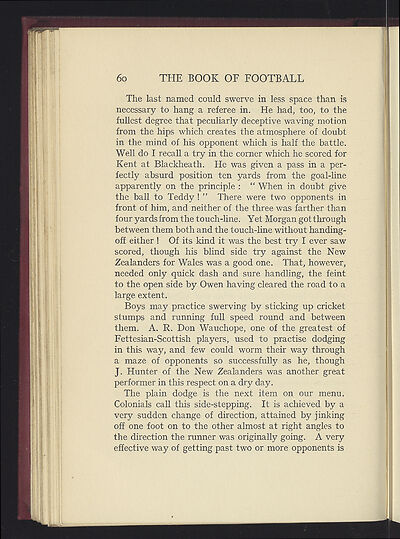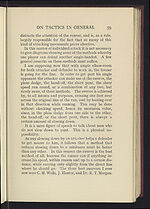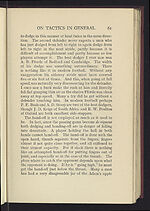Book of football
(84)
Download files
Complete book:
Individual page:
Thumbnail gallery: Grid view | List view

6o THE BOOK OF FOOTBALL
The last named could swerve in less space than is
necessary to hang a referee in. He had, too, to the
fullest degree that peculiarly deceptive waving motion
from the hips which creates the atmosphere of doubt
in the mind of his opponent which is half the battle.
Well do I recall a try in the corner which he scored for
Kent at Blackheath. He was given a pass in a per-
fectly absurd position ten yards from the goal-line
apparently on the principle : " When in doubt give
the ball to Teddy ! " There were two opponents in
front of him, and neither of the three was farther than
four yards from the touch-line. Yet Morgan got through
between them both and the touch-line without handing-
off either ! Of its kind it was the best try I ever saw
scored, though his blind side try against the New
Zealanders for Wales was a good one. That, however,
needed only quick dash and sure handling, the feint
to the open side by Owen having cleared the road to a
large extent.
Boys may practice swerving by sticking up cricket
stumps and running full speed round and between
them. A. R. Don Wauchope, one of the greatest of
Fettesian-Scottish players, used to practise dodging
in this way, and few could worm their way through
a maze of opponents so successfully as he, though
J. Hunter of the New Zealanders was another great
performer in this respect on a dry day.
The plain dodge is the next item on our menu.
Colonials call this side-stepping. It is achieved by a
very sudden change of direction, attained by jinking
off one foot on to the other almost at right angles to
the direction the runner was originally going. A very
effective way of getting past two or more opponents is
The last named could swerve in less space than is
necessary to hang a referee in. He had, too, to the
fullest degree that peculiarly deceptive waving motion
from the hips which creates the atmosphere of doubt
in the mind of his opponent which is half the battle.
Well do I recall a try in the corner which he scored for
Kent at Blackheath. He was given a pass in a per-
fectly absurd position ten yards from the goal-line
apparently on the principle : " When in doubt give
the ball to Teddy ! " There were two opponents in
front of him, and neither of the three was farther than
four yards from the touch-line. Yet Morgan got through
between them both and the touch-line without handing-
off either ! Of its kind it was the best try I ever saw
scored, though his blind side try against the New
Zealanders for Wales was a good one. That, however,
needed only quick dash and sure handling, the feint
to the open side by Owen having cleared the road to a
large extent.
Boys may practice swerving by sticking up cricket
stumps and running full speed round and between
them. A. R. Don Wauchope, one of the greatest of
Fettesian-Scottish players, used to practise dodging
in this way, and few could worm their way through
a maze of opponents so successfully as he, though
J. Hunter of the New Zealanders was another great
performer in this respect on a dry day.
The plain dodge is the next item on our menu.
Colonials call this side-stepping. It is achieved by a
very sudden change of direction, attained by jinking
off one foot on to the other almost at right angles to
the direction the runner was originally going. A very
effective way of getting past two or more opponents is
Set display mode to:
![]() Universal Viewer |
Universal Viewer | ![]() Mirador |
Large image | Transcription
Mirador |
Large image | Transcription
Images and transcriptions on this page, including medium image downloads, may be used under the Creative Commons Attribution 4.0 International Licence unless otherwise stated. ![]()
| Sports publications > Book of football > (84) |
|---|
| Permanent URL | https://digital.nls.uk/231443582 |
|---|
| Description | More than 230 sports publications from the National Library of Scotland's collections. Featured sports include football, rugby, golf, shinty, athletics, bowls, cricket and hockey. Among the material from the late 19th and early 20th centuries are match programmes, club histories, and handbooks. From the late 20th century are promotional materials to encourage greater diversity in sport. Most items cover sports activities in Scotland. There are also publications relating to the Olympics and international matches. |
|---|---|
| Additional NLS resources: |
|

